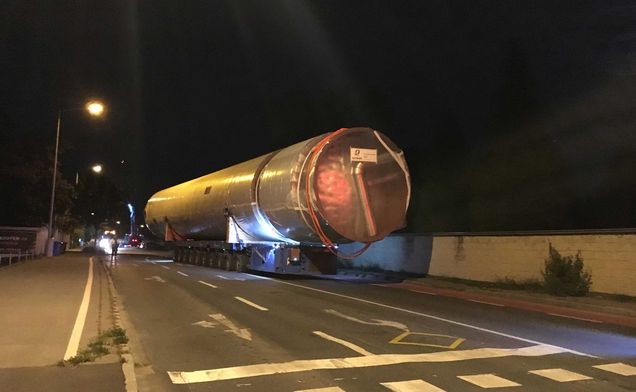Special transport for Power Tower
October 30, 2017 | Markus Lackner
The start of the provincial capital of Graz’s supply with district heating dates back to the 1960s. Currently, some 30 per cent of the demand are met by ecological waste heat and solar heat.
For some time, one of the major contributors to heat generation has been the Marienhütte steel and rolling mill in the Reininghaus district. There, heat extraction systems and highly efficient high-capacity heat pumps have previously been used to process industrial waste heat and feed it into the district heating grid of Graz. By partnering with Energie Graz, the company has set another important milestone by creating the so-called Power Tower. It is supposed to supply alternative district heat to some 12,000 residents of a new urban development area in Reininghaus. Two 30-metre district heating storage systems with a capacity of some 600 cubic metres are one prerequisite. The Wels-based equipment manufacturer Bilfinger VAM Anlagentechnik had been commissioned with their production.
30-metre load on fixed vessel bed trailer
“It was some challenge,” Clemens Felbermayr from Felbermayr’s Heavy Haulage Department says about the job and emphasises the use of the fixed vessel bed trailer. Loaded with the 30-metre-long and 4.5-metre-wide components, space was at a premium, especially in the urban area of Graz. After all, the vehicle combination including tractor unit, vessel bed trailer and seven-axle flatbed configuration achieved a length of more than 52 metres. “Due to spatial constraints, the last kilometre had to be negotiated with a self-propelled modular transporter (SPMT),” says Felbermayr, who regarded entering the works premises as particularly difficult. In the end, however, the two district heating storage systems safely reached their destination at the premises of Marienhütte.
Truck-mounted cranes deployed to lighthouse project
Supported by an LTM 1100 as the tracking crane, an LTM 1750 was used as the main crane to lift the two tanks into place. “First, we attached the main crane’s bottom hook block to the tank cover, after which the tracking crane was connected to the tank’s floor,” Felbermayr illustrates the crane job’s preparation. Subsequently, the district heating systems were lifted using the main crane, and the tank floor with the LTM 1100 tracking crane. Once the tank had reached its vertical position, the tracking crane was disconnected. “The main crane was then used to lift the tanks into position,” says Felbermayr, glad that almost no wind threatened the crane job at the time. Thus, the two tanks could be lifted into place in less than seven hours. By the end of the year, the two district heating storage systems are supposed to be connected to the grid and supply surrounding households with 97 degrees Celsius. This will, on the one hand, conclude a lighthouse energy project and, on the other, set another milestone in the 20-year energy partnership between Marienhütte and Energie Graz.







